桃源乡
(日)石原和幸
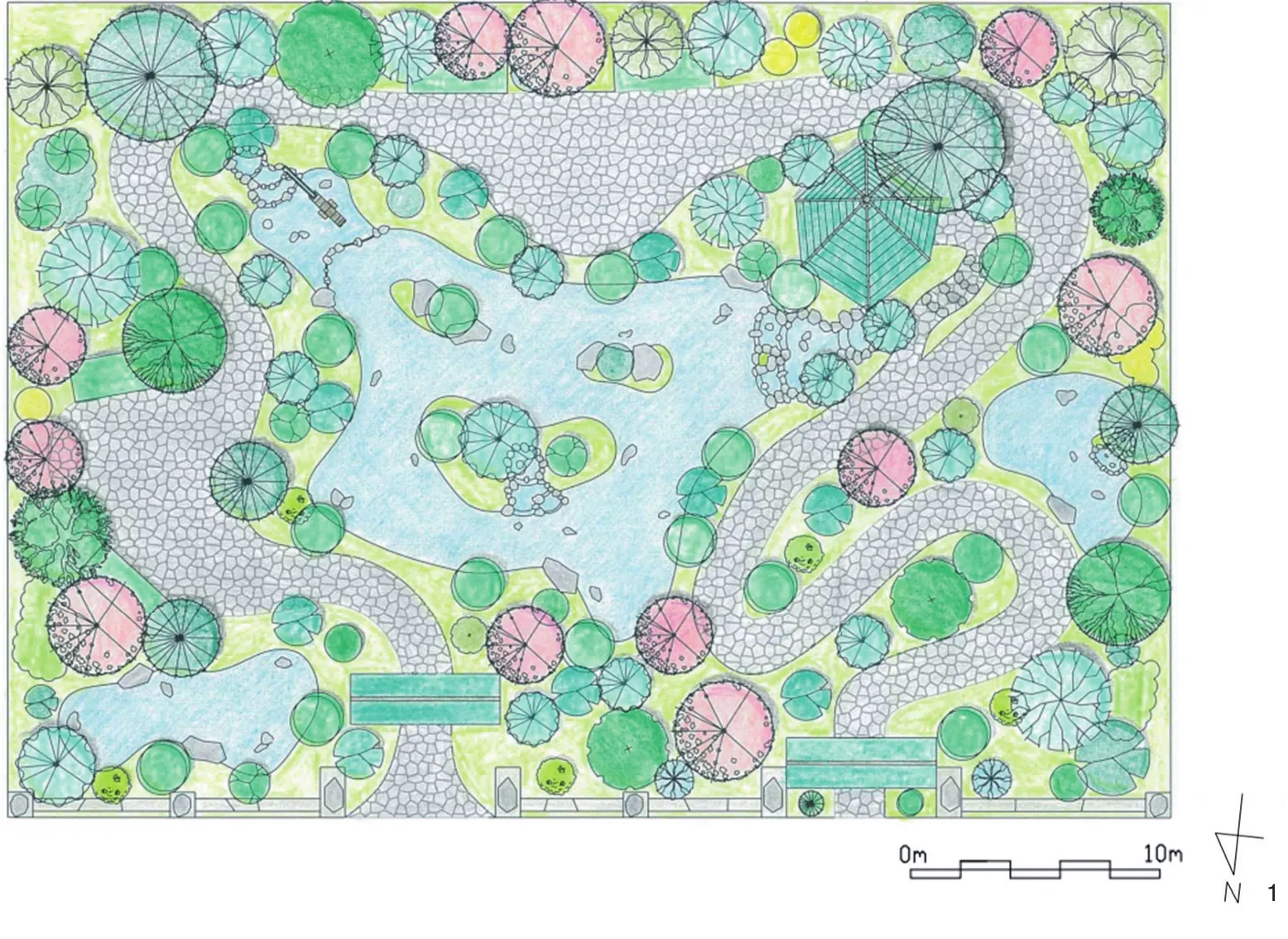
1总平面图Site condition plan

2 鸟瞰效果图Aerial view
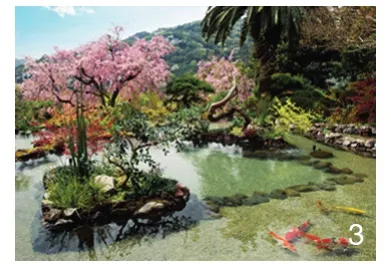
3岛意向图Island intention
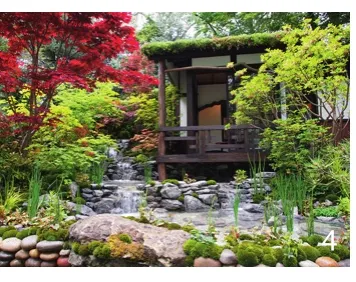
4 跌水意向图Folded water intention
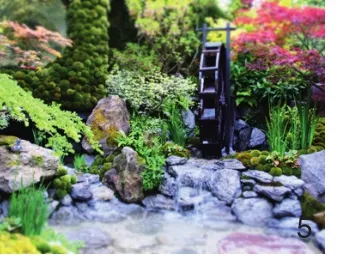
5 水车意向图Waterwheel intention
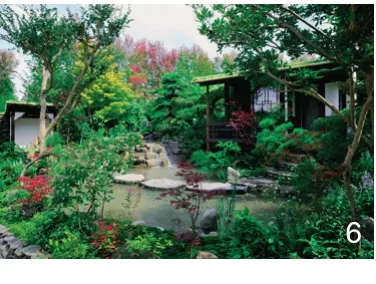
6种植意向图Planting intention
《桃花源记》是一篇描写世外桃源的中国文学,展现了居住在世外桃源里的人们所创造的自然风景。这些通过亲近自然获得美好生活的人们,是北京世园会生态学理念目标的先驱者。
将这种亲近自然的生活方式与少年时期铭记于心的风景及桃源乡进行叠加,并以此为题建造庭园,重现日本或是中国逐渐消失的风景,会让人回想起与自然亲近的生活方式。
设计概念
《桃花源记》中有这样的描述,穿过桃花林与水溪旁狭窄的入口,空间豁然开朗,有肥沃的田地、美丽的池沼及纵横交错的田间小路。庭园整体的构想与桃源乡相同,将富含花与水的幻想空间作为设计目标。
庭园中的多处场地以水面覆盖,可以感受到丰富的瀑布跌水景观与近水的植物景观。水池采用自然的形态,弱化人工雕琢的痕迹,园路围绕水池一周,象征着人与水相依相存。中央位置的水池两端分别设置亭子与水车,营造人们在此生活的景象,并通过雾化鼓风机释放雾气,营造梦幻般的气氛,给人以亭子悬浮于空的印象。庭园边界附近栽种植物,象征与外界隔绝,同时为避免对庭园内景观产生干扰,控制大乔木种植,形成内部开阔的空间。此外,庭园内整体配植桃树及与桃树同属的梅桃等植物,表达花乡之意。
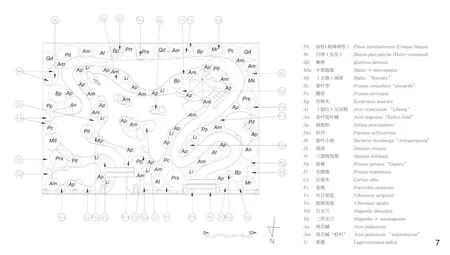
7 种植方案平面图Planting Plan
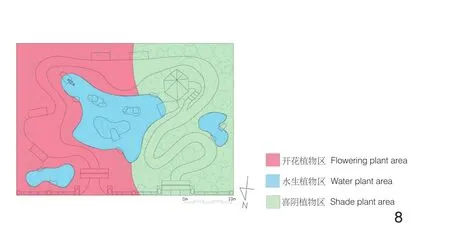
8 植物分区图Plant zoning plan
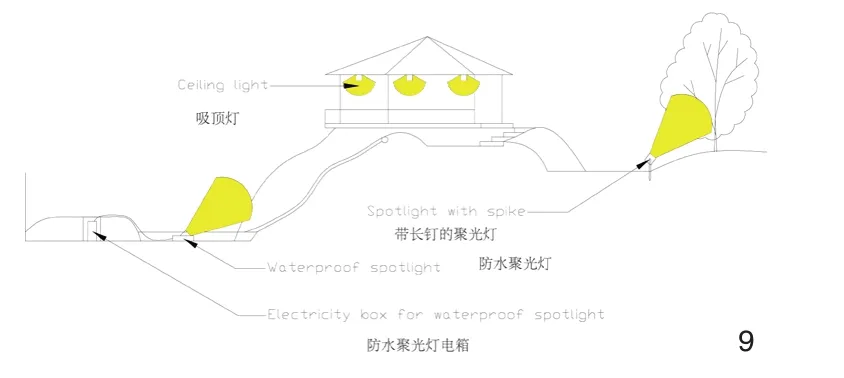
9 照明设置示意图Lighting setting
种植构思
庭园的种植设计将以色彩作为主题。在自然界中可以看到各种各样的色彩,不仅是叶子的色彩浓淡,也包括花、果实及彩叶植物的不同色彩。在被广告牌的强烈色彩包围的现代生活中,这些来自自然界的色彩是十分必要的。模仿由季节产生的自然变化则相对比较困难,本次设计将以通过植物色彩利用加强不同季节的印象作为植栽目标。
展园所在区位的冬季严寒是一个挑战,本次设计在可使用的植物中,选定可以体现四季色彩变化的植物。此外,为延续桃花源记的主题,在全园内配植桃树以及同属植物。同时为了植栽配色,将推荐植物名录以外的鸡爪槭(Acer palmatum)、鸡爪槭‘松村’(Acer palmatum‘matsumurae’)、紫薇(Legerstroemiaindica)、玉蝉花(Iris ensata)等植物列入种植设计。
•木本植物
此次设计中使用的乔木主要分为4类。其中包括春季观花类的植物(樱花、桃);夏季多雨季保持优良观赏姿态的植物(苔藓、荚蒾、紫薇);秋季观彩色叶类的植物(槭树类、樱);以及冬季枯叶期保持良好观赏价值的植物(松、白桦、红瑞木、槲树)。
在植物造景的手法中,并没有采取植物群落搭配的手段,而是通过多树种重叠,以多种色相以及植物颜色的浓淡对比作为主要的植物造景手法。例如,深叶色植物与浅叶色植物并置;橙红叶色树木与赤红叶色树木并置。在日本的自然景观中,眺望郊野的山体,会在树木的萌发期及红叶期呈现出丰富的马赛克状的颜色图案形式。本次的展园中,也采用类似的非均一式的斑块状颜色图样来表达。
•草本植物
此次设计中,以宿根类植物作为主要的草本植物类型。由于一二年生草本的生命周期较短,无法表现出桃花源永恒存在的主题特征,因此选用多年生草本来表达时间流逝的体验。草本植物的种植策略,与庭园整体的安定静寂的气氛相符合,选用与苔藓相配的种类进行栽植。
场地东侧为开花植物区,种植喜阳植物,形成花色缤纷的景观,如欧洲银莲花、常夏石竹、山桃草、西伯利亚鸢尾、针叶天蓝绣球、林荫鼠尾草等;场地西侧为喜阴植物区,选择耐阴植物为主要的草本种类,如落新妇、萱草、珊瑚铃、玉簪、黄水枝等,结合苔藓形成宁静优雅的空间;水生植物区种植水生植物营造水景,如睡莲、梭鱼草、再力花、小香蒲、玉蝉花等。
(编辑/王一兰)
主设计师:石原 和幸
设计团队:阿部 直角,小田 智博
企划担当:原 純子
日文翻译:马嘉,王培严,陈瑞
英文翻译:万静柯
The articleThe Peach Colonywhich describes the story of “a paradise on Earth” show us the natural scenery created by people who live in the peach colony. Those people who gained wonderful life by being close to nature are the pioneers under the goal of ecological concept of Beijing Expo 2019.
Mr. Ishihara integrated this kind of lifestyle of being close to nature with the scenery where he had experienced and kept deeply in his mind in adolescent period and “a Paradise on Earth”, so he decided to create garden according to this. Meanwhile, recurring Japanese or Chinese scenery which is gradually disappearing reminds people of the lifestyle of being close to nature.
Design Concept
It is described inThe Peach Colonythat going through the narrow entrance between the peach forest and the river, the space suddenly becomes large and bright. There are fertile farmland, beautiful pools and ponds, and intersecting paths in the fields. The integral concept of garden is same as “a Paradise on Earth” taking the imaginative space full of flowers and water as my goal of design.
There are many sites covered by water in garden,which can make people feel the ample landscape of waterfall running down and plants near the water.Pools are designed in natural form, weakening the trace of artificial carve, and the road of garden surrounds the pool for a round, which is a symbol of interdependence between man and water. Pools located at the center are respectively equipped with pavilion and waterwheel at both ends, creating the scene that people live here. And releasing the mist by atomizing air blower creates dreamy atmosphere,impressing people the feel of a pavilion suspending in air. Plants are grown near border of garden representing the isolation from outside world. At the same time, for the purpose of avoiding interference to landscape in garden, the planting of large plants need to be limited so as to form wide space. In addition,only peach trees and plum trees or some trees which belong to the same family are planted for matching with the garden in order to express the meaning of flower town.
Planting Concept
The design of garden is themed on colors.There are various colors in the nature, which not only include different shades of leaves, but also different colors of flowers, fruits and color-leafed plants. In modern life, the buildings composed of solid concrete are surrounded by the intense colors of billboards. So it is very necessary to have the colors of the nature. It’s pretty difficult to imitate seasonal variations. Therefore, this design is aimed at reinforcing different impressions of seasons with the usage of colorful plants.
The freezing weather conditions in winter would be a challenge. So among the alternative plants in this design, we choose the plants that can show the color variations in the four seasons. Besides, in order to continue the theme of “the paradise on earth”,peach tree and its congeneric plants are planted in the garden. Moreover, considering the plant color scheme,we recommend the plants that beyond the plant list,such asAcer palmatum,Acer palmatum‘matsumurae’,Legerstroemia indicaandIris ensata.
• Xylophyta
The trees used in this garden fall into four categories: the spring flowering plants (Prunus serrulata,Prunus persica); the plants that can keep good ornamental in rainy summer (moss,Viburnum opulus);the plants that have colorful leaves in autumn (Acer,Prunus serrulata); the plants that are with high value of appreciating (Pinus tabulaeformis,Betula platyphylla,Cornus alba, andQuercus dentata).
We do not take collocation the of herbaceous vegetation communities as the means of planting design, instead of overlapping multiple trees species and using many colors and different shades of leaves to form a contrast. For example, deep-coloredleaf plants and light-colored-leaf plants are placed together; orange-and-red-leaf trees and crimson-leaf trees are put together. In Japanese natural landscape,overlooking the mountains located at outskirts, we would find the pattern of richly mosaic color and when the trees are during the periods of germination and red leaves, which is applied to the garden at this time.
•Herbaceous Vegetation
Perennial plants are the main herbaceous plants used in this design. Since the biennial herb has a rather short lifespan and can’t embody the theme of the “the paradise on earth” lasting forever, we choose perennial herb to express the feeling of time passing by. The planning of growing herbaceous vegetation is in line with the peaceful and quiet atmosphere in the whole garden. We choose the plants that are matched with moss.
The east of the place is flowering plant area where sun-loving plants are grown. These plants bloom very well making the place splendid. They includeAnemone coronaria,Dianthus plumarius,Gaura lindheimeri,Iris sibirica,Phlox subulataandSalvia×nemorosaand something like these. And the west of the place is shade plant area where shade plants are integrated with moss creating calm and graceful atmosphere. And shade plants areAstilbe chinensis,Hemerocalis,Heuchera,HostaandTiarella, ect. The rest of the place is water plant area where plants live in water, and they help to make the waterscape. These plants includeNymphaea,Pontederia cordata,Thalia dealbata,Typha minima,Iris ensataand so on.

